Arctic cold invaded Jesse Brown’s cockpit as he desperately looked for a place to land his F4U-4 Corsair in the snow-covered mountains of North Korea, near the Chosin Reservoir.
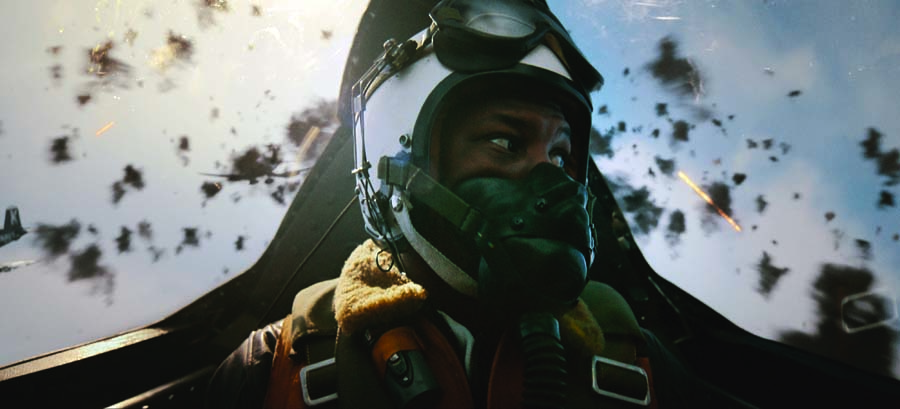
Jonathan Majors plays Jesse Brown in Columbia Pictures’ “Devotion.” In this still from the film, he’s in the cockpit of Brown’s VF-32 Corsair. But he was actually filmed in the rear cockpit of Lewis Air Legends’ T Mk. 20 Sea Fury with Steve Hinton flying.
It was early December 1950. More than 120,000 Chinese troops had crossed into North Korea and encircled 30,000 troops from the U.S. Marine Corps’ 1st Division, the U.S. Army’s 7th and 3rd Infantry Divisions, and U.N. forces around the reservoir with the goal of annihilating them.
Brown was America’s first Black naval aviator and the first to fly combat missions. He and his VF-32 wingman LTJG Tom Hudner had taken off from the aircraft carrier USS Leyte (CV-32) in the Sea of Japan to provide low-level close-air support for the Americans trying to break out of the encirclement.
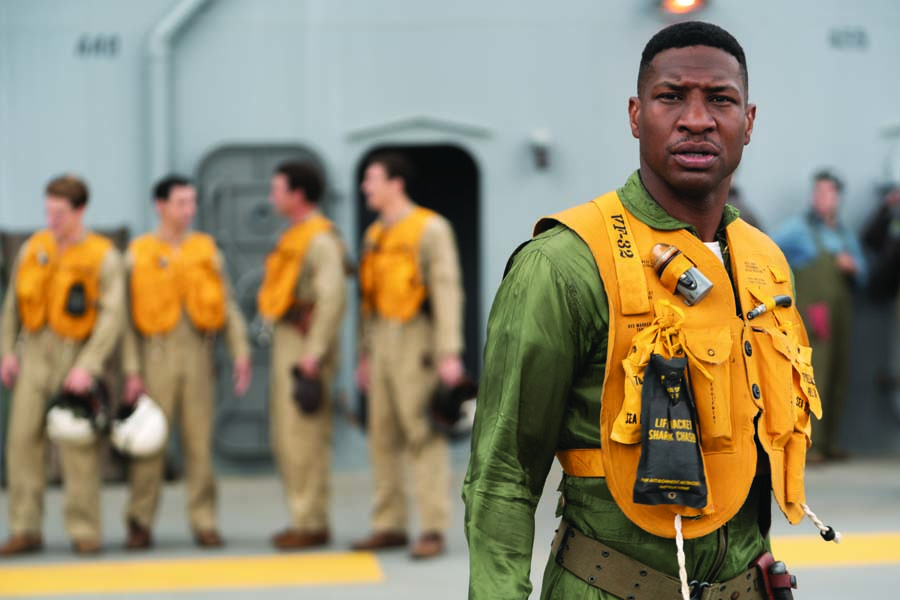
Majors in a period-correct flight suit and Mae West on the set of the mock-up USS Leyte at Bulloch County Airport in Statesboro, Georgia. (Photo by Eli Adé/Columbia Pictures)
A “golden bullet” fired by Chinese troops pierced a fuel line in the big Pratt & Whitney R-2800 radial just in front of Brown, damaging it so severely the engine quit. He had to crash-land.
Seventy years later, Mike Oliver, pilot and general manager of the terrific Erickson Aircraft Collection in Madras, Oregon, dropped inexorably downward toward the snow-covered Cascade Mountains until the propeller tips of his F4U-7 were feet above icy pine trees.
“The shot was, I get shot down.” Oliver recalls. “I’m smoking, looking for a place to land. I turn base to final, find a place out there in the mountains, roll the canopy back and put the flaps down. I had a camera mount on the tail, so it’s showing that different view. I was sinking, sinking, sinking all the way down to the trees.
“That was a moment where as a pilot, I couldn’t imagine landing in the mountains of North Korea when there are people trying to kill you, let alone the terrain.”
It’s one of the most vivid memories Oliver has of the filming for the new movie “Devotion,” which recently premiered. Based on the book of the same title written by author Adam Makos, it’s the true story of Navy pilots Jesse Brown and Thomas Hudner Jr., their devotion to each other, and their astounding bravery during the Korean War.
“It’s a beautiful, incredible story,” Kevin LaRosa adds. “And we felt the weight of that on our shoulders to do our best to tell it with the money, time and assets we had.”
LaRosa was the aerial coordinator for Devotion, the same position he held for the blockbuster “Top Gun Maverick.”
In 2020, the two were part of a small group of warbird and camera-ship pilots who did the flying and filming for Black Label Media/Sony Pictures’ new film. I spoke to them about the experience of making “Devotion.”
“It’s a beautiful, incredible story …And we felt the weight of that on our shoulders to do our best to tell it”
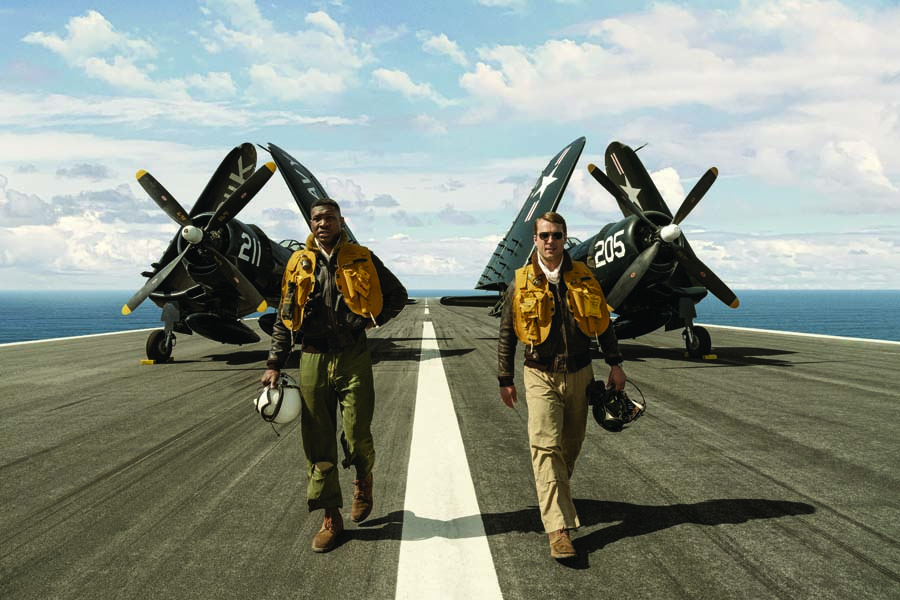
Majors (left), who plays Brown, and actor Glen Powell, who plays Thomas Hudner Jr., stride aft on the mock-up flight deck of the USS Leyte. Computer-generated imagery (CGI) was used sparingly in “Devotion.” Here’s an instance where the water surrounding the flight deck, created on one of the two runways at Bulloch County Airport, is CGI. (Photo by Eli Adé/Columbia Pictures)
The Cast
Actors Jonathan Majors and Glen Powell lead the cast as Jesse Brown and Tom Hudner. But there were two more casts. One, the aircraft, is seen on-screen in majestic fashion. The other, the warbird and camera-ship pilots (with one exception), was strictly behind the scenes.
Six sources supplied the warbirds used in the movie. Erickson provided their F4U-7 and AD-4W Skyraider. Planes of Fame sent their F4U-1, F8F-2 Bearcat, and MiG-15. Comanche Aviation contributed its F4U-4 and F8F-2. The Commemorative Air Force’s FG-1D was on hand from AirBase Georgia. So were Lewis Air Legends’ T Mk. 20 Sea Fury and Anduze Helicopters’ extremely rare Sikorsky HO5S-1.
Steve Hinton Sr., Steve Hinton Jr., John Maloney, Mike Oliver, Jim Martinelli, and Alex Anduze were the warbird pilots. They flew both “picture-ships,” the warbirds that appear on-screen, and “camera-ships,” warbirds that had internally and externally-mounted film cameras.
Kevin LaRosa flew his “Cinejet,” an L-39 Albatross specially modified as a camera-ship for movie, TV, and commercial work, and a Eurocopter AS 350, also specially modified for filming.
Erickson’s Corsair was already in Jesse Brown’s markings before Oliver had any idea a movie would be made. A friend who knew Adam Makos introduced the two. They chatted extensively and Mike read Makos’ book.
“I wasn’t familiar with the story,” Oliver notes. “I read the book and thought it was awesome.” With Erickson’s staff already in the process of refreshing the collection’s F4U-7, he had an inspiration.
“I said, ‘Let’s dedicate this restoration to Jesse Brown and paint the airplane in his colors. That’s what we did, and this was in 2018, way before the movie.”
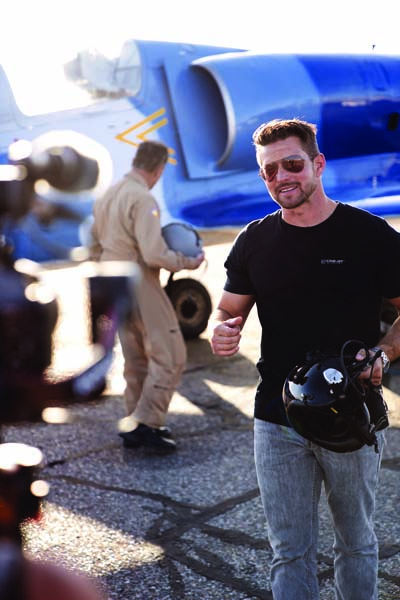
Kevin LaRosa was the aerial coordinator for “Devotion,” a responsibility he also had for the blockbuster “Top Gun Maverick.” (Photo courtesy Kevin LaRosa)
Hence “211” portrayed Jesse Brown’s Corsair with Oliver at the controls for filming primarily as well as Steve Hinton Sr. Steve Hinton Jr. was the primary pilot of “205,” Comanche Aviation’s F4U-4 that represented Tom Hudner’s Corsair. Hinton Sr. and John Maloney did most of the flying in the Bearcats that represented VF-32’s fighters before the squadron’s transition to Corsairs ahead of deployment to the Korean War.
The F4U-1 and FG-1D played mainly supporting roles as camera-ships with external cameras mounted and as extra Corsairs on screen, filmed so as not to reveal the features of their airframes, which identify them as World War II-era versions of the fighter.
Scenes in which actors Majors and Powell were shown in the cockpit of the Brown/Hudner Corsairs/Bearcats were actually shot in the rear cockpit of Lewis Air Legends’ Sea Fury with Hinton Sr. flying up front says LaRosa.
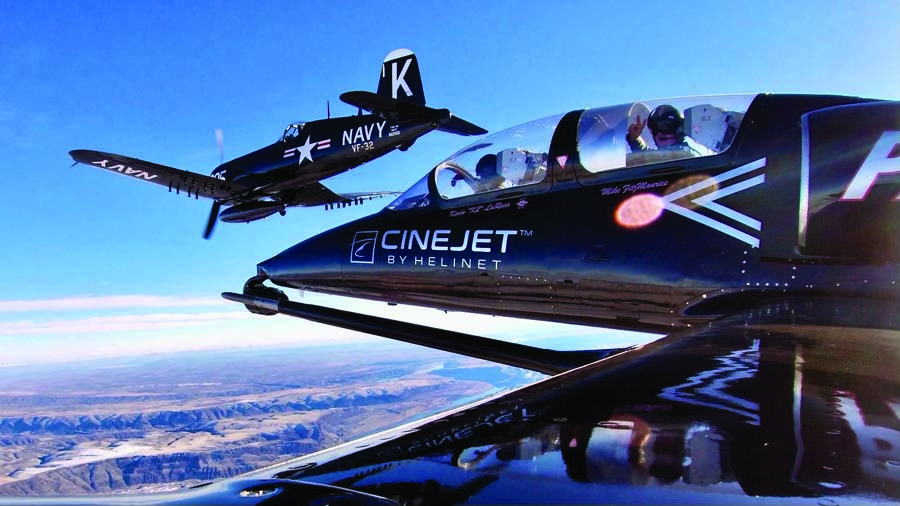
Coordinator Kevin LaRosa pilots the L-39 “Cinejet” with aerial director of photography Roger Tonry in the aft cockpit looking at the camera. The pair also worked on “Top Gun Maverick” and are closed up tight on Comanche Aviation’s F4U-4, the Corsair portraying Hudner Jr.’s airplane. (Photo courtesy Kevin LaRosa)
“I wasn’t familiar with the story,” Oliver notes. “I read the book and thought it was awesome … I said, Let’s dedicate this restoration to Jesse Brown and paint the airplane in his colors. That’s what we did, and this was in 2018, way before the movie.”
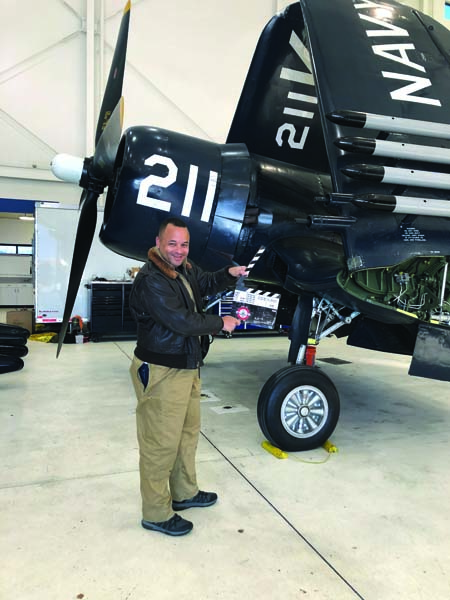
Mike Oliver poses with a director’s action/cut clapper board in front of Erickson Aircraft Museum’s Corsair, the “hero” aircraft in “Devotion.” (Photo courtesy Mike Oliver)
“If you look at the Sea Fury’s rudder, vertical stabilizer, and tail, they resemble the Corsair or Bearcat close enough to where we painted the back of the airplane to match them. That’s what we put our actors in [when we] actually go out and do maneuvers.”
Hinton Sr. also flew the MiG-15 in the scenes where it appears, and Alex Anduze flew the HO5S-1 that depicts the rescue helicopter flown by 1st Lt. Charlie Ward, the Marine who rescued Tom Hudner. Erickson’s AD-4W Skyraider flown by Jim Martinelli appears on screen as well. It’s one of the very few elements in the film where computer-generated-imagery, known as CGI, was used.
The AD-4W was the three-seat, airborne early warning/anti-submarine warfare version of the single-seat AD-4 used for strike. LaRosa reveals that the filmmakers CGI’ed Erickson’s W-model to make it look like an AD-4.
On Location
The flying scenes in “Devotion” were filmed in two locations: around Wenatchee and Pasco Washington, and near Savannah and Statesboro, Georgia.
“I have to give Black Label Media and Sony a ton of credit,” LaRosa says. Despite the fact that the movie’s budget was a fraction of the spend for “Top Gun Maverick,” “they wanted to film the airplanes in harsh conditions,” he explains. “Out in the snow and ice of the Washington mountains like they would have been in Korea, and over the sea or on the USS Leyte as we did around Georgia.
“That’s a daunting task,” he adds. “We were asking a lot of 70-year-old aircraft that live in heated hangars in museums and collections.”
In Pasco, where temperatures dropped below freezing, snow and ice had to be cleared from the ramp of the local airport “so the airplanes wouldn’t skid as they taxied,” LaRosa recalls.
The warbirds were bedded down in World War II era hangars, Oliver notes. “There was a lot of effort with a lot of people just getting the doors open, getting the airplanes warmed up, keeping them warm so we could start them. Then once we’re done for the day, throwing them back in the hangar, getting the heaters on, making sure there’s gas in the heaters so they don’t run out!”
Next to one of the runways at Bulloch Country Airport in Statesboro, Georgia, northwest of Savannah, the Black Label Media crew built a full-size mockup of the USS Leyte’s superstructure and flight deck.
“It allowed us to have our picture ship pilots takeoff and land and simulate arrested landings with hooks down with the superstructure right next to them,” LaRosa says. “It worked really well.”
Mike Oliver described landing aboard the mock carrier as some of the movie’s more challenging flying, particularly for scenes he was assigned wherein VF-32 pilots are getting carrier-qualified in their F4U-4s. In some scenes, Oliver had to make his Corsair act like that of an anxious pilot trying to trap on the Leyte.
“Even though they could grease a Corsair to the runway and hit a one-foot marker every single time landing, I’d have to tell the picture ship pilot that this particular pilot is very nervous,” LaRosa explains. “‘We need a very shaky approach behind the power curve.’”
“They looked like drunk aviators, but they flew those bad approaches with precision to the movie story point.
“The way it was set up with the carrier deck on the side of the runway, there were cameras all over the place,” Oliver recalls. He flew 15 simulated carrier landings and takeoffs on-set at Bulloch County Airport.
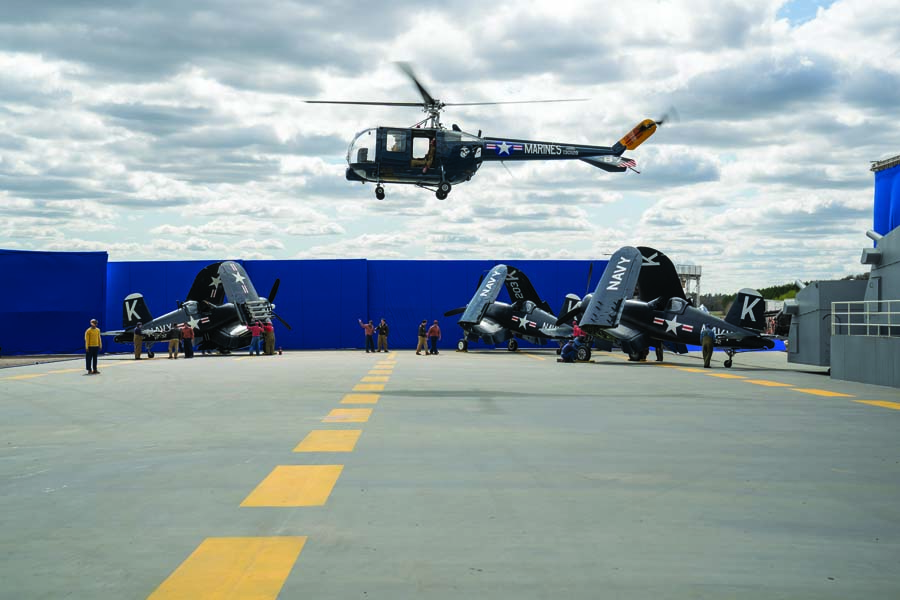
Alex Anduze hovers the world’s only airworthy Sikorsky HO5S-1 above the mock-up flight deck of the USS Leyte on-set at Bulloch County Airport. Anduze’s HO5S-1 represents the HO3S-1 that USMC Lt. Charlie Ward rescued LTJG Hudner with. Below, left to right, are Erickson Aircraft Museum’s F4U-7, CAF Airbase Georgia’s FG-1D, and Planes of Fame’s F4U-1. (Photo by Eli Adé/Columbia Pictures)
“There was a big tent on the other side of the runway from the superstructure, so you had this narrow little passage between them. It was kind of intimidating, particularly flying slow to where they wanted you to touch down on a specific area, a piece of tape.”
“The deck wasn’t that big. Trying to do that the first two or three times I overshot or came up short or wheel-landed it. They wanted a full three-point, slam it on the ground, hook-down and then some go-arounds, too, once you hit the ground. But after half of them it got to be where it was a no-brainer.”
“Standby… Action!”
“It’s my job to put the picture ships in the right spot,” LaRosa says. “We’ve got to be in the right place to have the right background, especially if we’re doing 200 knots together. I’ll put us in the right spot, make sure the lighting is good and say, ‘Standby guys, we’re getting close.’ Now my picture-ship pilots are ready and focused and I’ll say ‘three-two-one, action!’”
He explains that once joined in formation with a camera-ship or filming from a position farther out, the cadence of his voice is important so that his direction to the picture-ship pilot is precise and predictable.
“They’ll power up and maybe I’ll say, ‘Right break, right break, ready … Now!’
“Then they do the maneuver. I’ll tell them when the camera cuts and they’re clear to make a left or right turn back to rejoin. There’s a whole host of other things that the aerial director of photography, Michael FitzMaurice who operates the camera, and I are saying inside the aircraft, a lot happening behind the scenes.”
The warbirds were also camera-ships at times, equipped with external cameras that could be turned on by the warbird pilot and video monitors in-cockpit so the pilot could see what the camera was capturing. Scenes in which the view from the warbird was important—flying through a canyon or over a river at low level—required the pilots to “become their own director of photography with the lighting,” LaRosa reveals.
Below aircraft that star in “Devotion” include this trio from Planes of Fame: an F8F-2 Bearcat, a MiG-15, and an F4U-1 wearing its theatrical makeup as a Korean-era VF-32 Corsair.
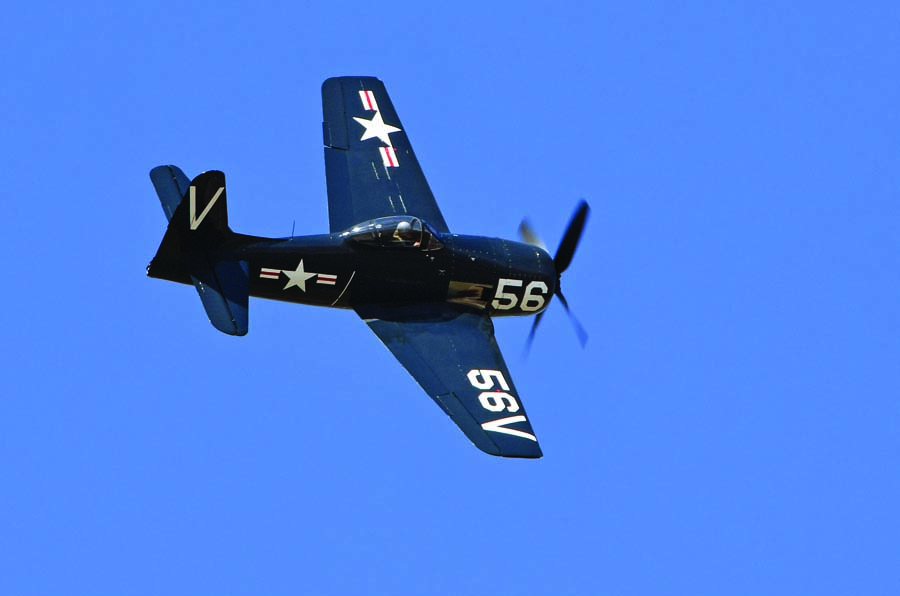
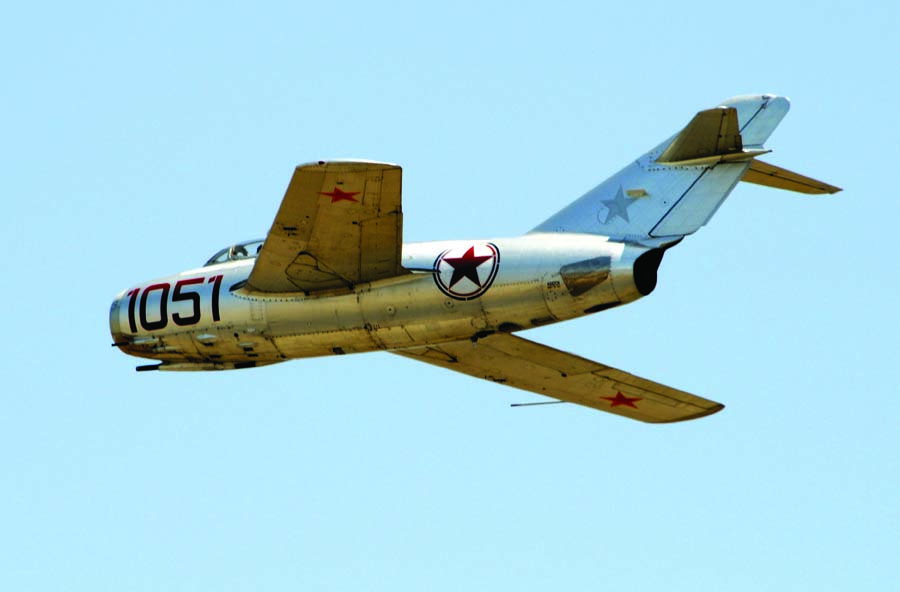
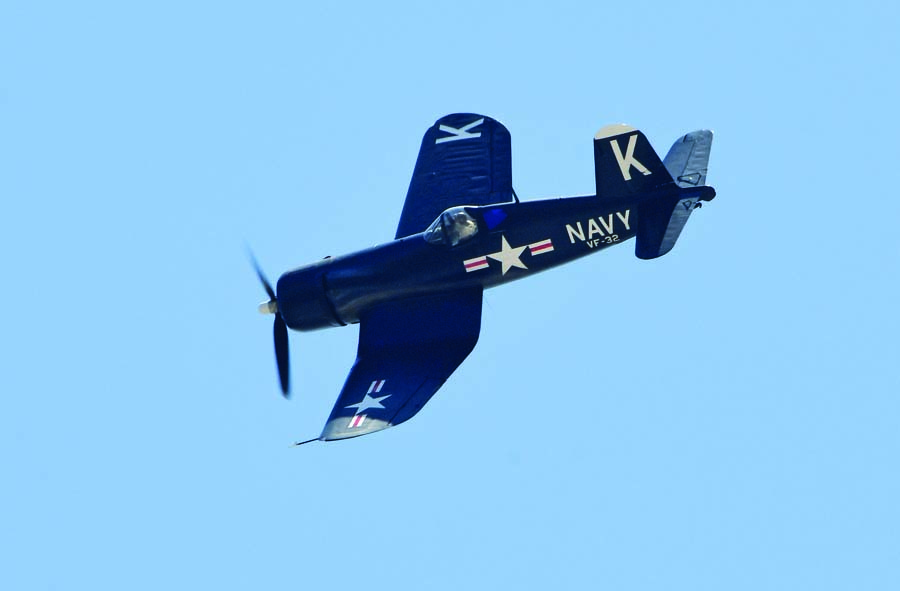
“We give them that responsibility,” he explains. “If Steve Jr. has cameras mounted to his airplane, he can run a canyon, reference those monitors and see where the light is, where the glints are. That’s what makes things cinematic and dynamic.
“You’re always focused on camera angles,” Oliver says of the movie flying. “In our airplane we had one or two cameras attached. In formation and doing maneuvers you always wanted to make sure that the airplanes are in-picture, make sure they show good and make sure the angles and lighting are good.
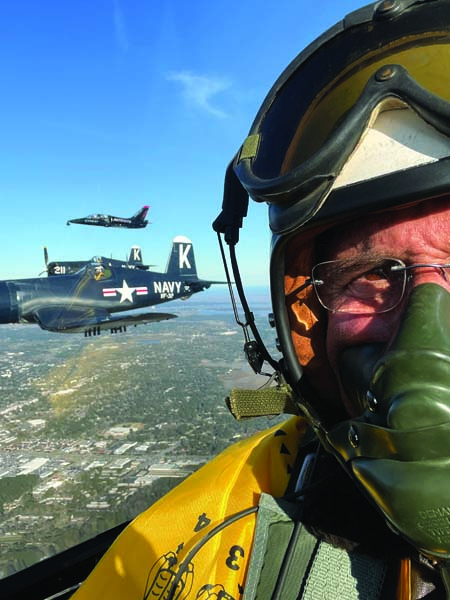
Steve Hinton flies Comanche Aviation’s F4U-4 with son Steven Hinton on his right wing in Planes of Fame’s F4U-1, Mike Oliver in Erickson’s F4U-7, and Kevin LaRosa stacked up high in the L-39 “Cinejet.” (Photo courtesy of Steve Hinton)
“If they’re flying a Corsair through a canyon and I’m flying the L-39, in the back of their head, they’re picturing what the camera on my aircraft is seeing,” LaRosa says. “That’s called knowing your lens. That makes an amazing picture-ship pilot, and that’s why Steve Hinton is so incredible. Steve Jr. is, too.”
“You’re always focusing on that,” Oliver agrees. “And flying and doing all the maneuvers. So it was different than airshow flying. Sometimes it was challenging, but I could do it forever. I love that type of stuff!”
LaRosa says Oliver “knocked everybody’s socks off,” catching on to movie flying quickly and doing a terrific job.
Oliver credits the professionalism of LaRosa, the aerial production unit and his fellow warbird pilots.
“Flying with Steve Hinton and Steve Jr. gives you so much confidence. I’ve known Steve for a long time and he’s kind of the ‘dad’ of movie flying. I sat in the briefings and listened to him. He taught me a lot about the movie business, how you fly in the movies and all that stuff. Steve was awesome!”
A Cameo
Actors Jonathan Majors and Glen Powell got up close and personal with the warbirds they acted in and around in similar fashion to the actors in “Top Gun Maverick,” LaRosa reveals.
“We got Jonathan Majors in a Cessna 172 for some training, then eventually a T-6. It’s the same methodology we used on ‘Maverick.’ Tom Cruise kind of built that curriculum. We put the talent through the Cessna, Extra-300, L-39, and F/A-18. On ‘Devotion’ we put Majors in the Cessna, T-6, and Sea Fury.
“Glen has an iron stomach from all of his work on Top Gun Maverick,” LaRosa quips. “He’s now a certified pilot, too, so we sent him right to the T-6, then the Sea Fury. That was like a second home to Glen Powell.”
As mentioned, the warbird pilots are not seen on-screen, with one exception.
“The director, J.D. Dillard, needed a crew chief for Jesse,” Oliver laughs. “They asked me if I wanted to be the crew chief for Jesse/Jonathan Majors.
“I got a costume and all that stuff. I think there’s three scenes where you’ll see me in the movie on the airplane and next to it helping him don his helmet and get in the airplane or helping him with his parachute.
Fortunately says Oliver, he didn’t have any dialog to remember or speak. “If you’re not used to it, you have 500 people around you, looking at you. You have ten different cameras on you within a foot. I don’t know how these actors do it. You can get stage fright real quick!”
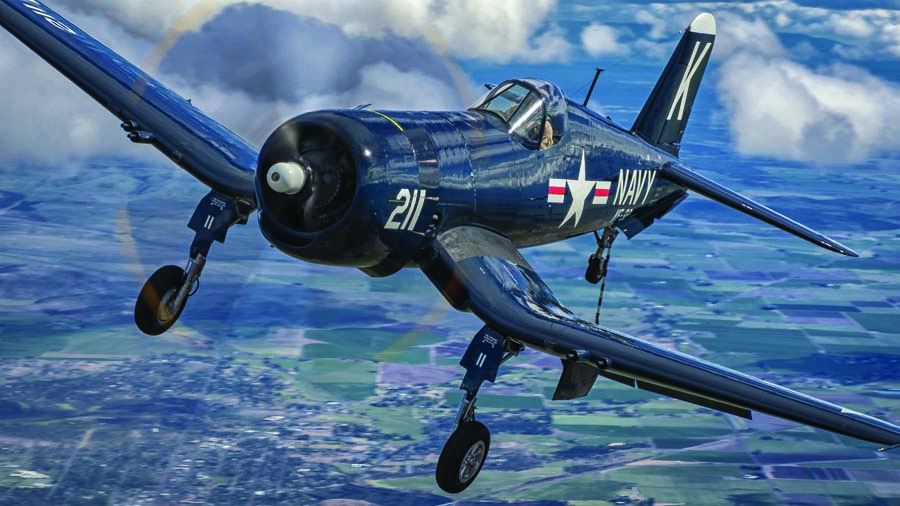
Mike Oliver “dirties-up” Erickson Aircraft Museum’s F4U-7 for the camera in its carrier-landing configuration, gear-down, flaps-down, hook-down.
(Photo by Gary Stray)
Unforgettable
In addition to flying the scene where Jesse Brown is forced to land his stricken Corsair, Mike Oliver says that meeting Brown’s widow Daisy and Tom Hudner’s son, Tom Hudner III, on set in Statesboro was unforgettable.
“We all got to meet them and I got to see Hudner’s logbook with the logbook entry for Jesse’s crash. That was amazing.”
That’s the main difference between “Devotion” and “Top Gun Maverick,” LaRosa stresses.
“’Devotion’ is a true story. When you see in Hudner’s logbook that it says, ‘Attempted to rescue Ensign Jesse Brown. Unsuccessful.’ … Those things give you chills. We’re flying these really cool airplanes and doing incredible shots. Then something like that hits you and you realize, ‘Oh man. This really happened!’”
LaRosa sums up the aerial filming with one impression; flying his L-39 camera-ship in tight formation with Steve Jr. then Mike Oliver in their Corsairs on separate flights over the Snake River in Washington for a scene where Brown dives down on the Yalu River in North Korea.
“I remember one day flying right up next to the Corsair at low level with this morning mist on the water and very cinematic light. It’s the kind of thing you dream of, stunning. I’ll never get that image out of my head.”
Actor Glen Powell says “Devotion” will “Blow your mind!”
“Steve Hinton is one of the best pilots in the world,” Glen Powell enthuses. “We got closer and closer until one pass where I thought we were going to explode on this lighthouse!”
Powell is referring to a scene in “Devotion” where Jesse Brown and Tom Hudner Jr. are flying F8F-2 Bearcats, “sniffing each other out and learning a bit about each other” as leader and wingman. The airborne, in-cockpit Bearcat scenes with Powell, who plays Hudner, and Jonathan Majors, who plays Jesse Brown, were actually shot with them seated in the rear cockpit of Lewis Air Legends’ T Mk. 20 Hawker Sea Fury with Steve Hinton in the front seat doing the real flying.
“We’re flying just off the coast of Savannah, really low along the beach, weaving in and out of the boats down there,” Powell tells me. “At the end, we rocket past this big lighthouse. It’s just a testament to Steve’s ability as a pilot. You see the sequence in the movie and the lighthouse rockets past the screen. When you’re flying with one of the best pilots in the world you have a level of confidence that you can do things that give you an adrenalin rush that will translate for the audience. They’ll feel that adrenaline!”
That’s quite an impression from an actor who’s probably most famous these days for his role in the blockbuster hit “Top Gun Maverick” as cocky Lt. Jake “Hangman” Seresin and who, like the other Maverick actors, logged a good bit of high-G seat time in the rear cockpit of an F/A-18F Super Hornet during filming.
He first learned about warbirds during the filming of “Top Gun Maverick,” when he was exposed to Tom Cruise’s P-51 that appears in the movie. “I never flew in the P-51 but hearing Tom Cruise’s passion for aviation and warbirds was infectious,” he explains. “I really found my own passion on this movie when we went to the historic aviation museums and got to learn about these planes, what makes them different and how they were used in combat. I got an appreciation for why they’re so special and that helped us capture what makes them special in this movie.”
One of Powell’s best memories of filming occurred when the cast and crew were shooting a scene on the mock-up of the USS Leyte. Mike Oliver was in the cockpit of Erickson Aircraft Collection’s F4U-7, the “hero” airplane. “Jesse Brown’s trying to land on the carrier,” Powell recalls. “We took a Corsair and flew it maybe 15 feet above the deck, right over the crew! Everybody was so hyped that day. It was so exciting!”
Powell’s sure aviation lovers are going to enjoy “Devotion.”
“What you’re going to see on the screen really brings history to life. It’s packed with heart but if you’re a history buff, especially about aviation, this movie is going to blow your mind!”
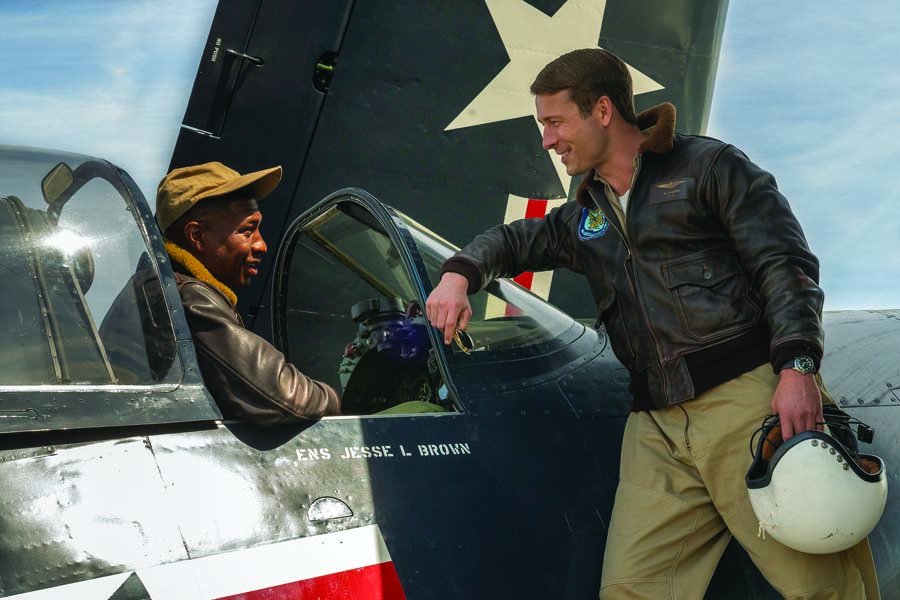
Actor Jonathan Majors as Jesse Brown in-cockpit with actor Glen Powell, who portrays LTJG Thomas Hudner Jr., on the right wing. (Photo by Eli Adé/ Columbia Pictures)
By Jan Tegler



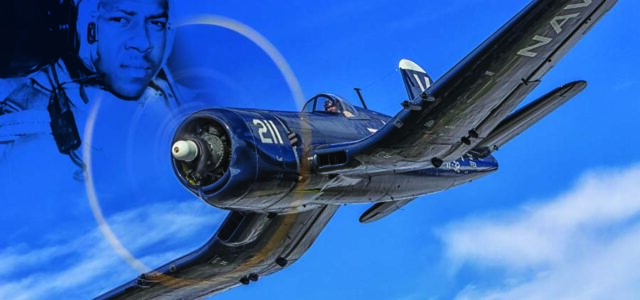













Several years ago I rode my Harley motorcycle by Double Eagle II airport (AEG) at Albuquerque, NM, when I noticed an F4U Corsair parked on the apron. I rode over to the gate, and I was able to walk out to the aircraft where the pilot told me that he was trying to replicate (one of) the planes involved in the occasion that precipitated award of a CMOH during the Korean War. I don’t remember if the F4U was number 205 or 211. I remember some numbers on the engine cowling, but I was most interested in the owner walking around, completing preflight checklist, yelling “clear,” and cranking that 2,000 HP P&W R-2800 Double Wasp cranking, coughing, and belching black smoke from its exhausts during both attempts to start before flames shot out and the beast roared to life. It was awesome to hear and watch as the F4U taxied, took off, and flew overhead for a ground-shaking departure. I’d never been near an F4U starting up or flying directly overhead. That was a real treat!
I served 20 yrs in the USAF, and my ears still ring from a lack of hearing protection while working next to the flight line when fighter jets launched at Nellis AFB. The C-17 backing up next to my building at Pope AFB during the DIOT&E was deafening as well. The F4U was a reminiscent high decibel level as well.